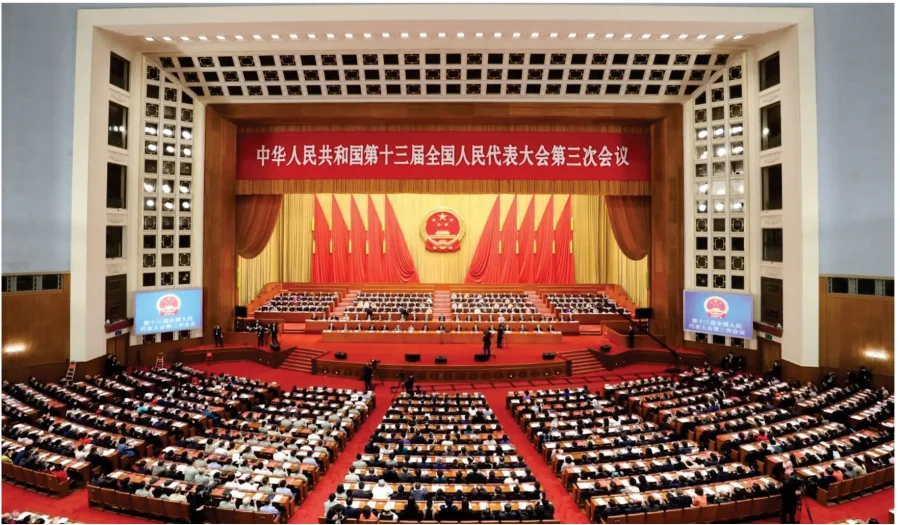China’s Two Sessions, BRI and CPEC
The historical conclusion of China’s Two sessions with the unanimous re-election of Xi Jinping as President have generated a message for the international community that the era of prosperity initiated by Chinese President Xi Jinping will be continued with full zeal and zest. International community has expressed their happiness on the re-election of Xi Jinping and it shows that President Xi enjoys the full confidence of its public and global community.
There are various triumphs achieved by President Xi Jinping for the Chinese public and the partner countries but the initiation of Belt and Road Initiative (BRI) has emerged as a blessing for Chinese citizens and international community as it has generated multidimensional benefits for them. It is recorded till now that around the world, 141 countries and 32 international organizations, including 19 UN agencies, have participated in the BRI.
This year marks the 10th anniversary of the BRI. With infrastructure construction a key priority, 81 Chinese central state-owned enterprises have been involved in over 3,400 projects in countries along the Belt and Road by January 2021. The cumulative amount of China’s direct investment in these nations reached 161.3 billion U.S. dollars from 2013 to 2021. A World Bank report estimated that when fully implemented, the BRI could help nearly 40 million people in relevant countries leave poverty behind.
BRI has not only boosted China’s economic development and trade growth but also helped enhance connectivity and cooperation in economic infrastructure, investment and finance and people-to-people exchanges among countries in the region and in the world. BRI is a high-quality public good initiated by China and jointly built by all partners, with its benefits shared by the world. Over the past decade, the BRI has brought nearly a trillion U.S. dollars of investment, established over 3,000 cooperation projects, created some 420,000 jobs in countries along the routes and helped lift nearly 40 million people out of poverty.
Responding to allegations that the BRI can lead to debt traps, the Chinese Foreign Minister, Qin Gang, said it is never China that should be accused of creating the so-called debt traps, citing data that multilateral financial institutions and commercial creditors account for over 80 percent of developing countries’ sovereign debt.
Under the flagship project of BRI, China-Pakistan Economic Corridor (CPEC) has proved itself as a vital economic tonic to Pakistan by administering those development booster shots that are revamping its infrastructure, energy, export, trade, transportation, agriculture, employment, medicine, IT, mobile technology and many more.
With these booster shots, during the last 10 years, more than 30 projects generating direct and indirect 200,000 jobs have been completed and more are in different phases of development, setting a tone for sustainable economic progress. Besides, more than 6,000 MW of electricity has been injected into the national grid, 809 kilometers of highway have been built and 886 kilometers of transmission lines have been installed for the first time in the history of Pakistan.
CPEC has also earned recognition from the World Bank Report entitled “The Web of Transport Corridors in South Asia”. “With investment in road, railways and ports, the more than $60 billion China-Pakistan Economic Corridor (CPEC) offers enormous potential for Pakistan to boost its economy, reduce poverty, spread benefits widely and help those likely to be affected by the new trade route. CPEC has to be analyzed as per its impact and performance setting aside traditional prejudices. One thing that must be kept in mind by doomsayers is that CPEC is not a remedy for governance weaknesses, system hiccups, political instability, bureaucratic red-tapism and corruption. Such hideous dynamics are the creeping root cause behind Pakistan’s limping economy.
Since its inception ten years ago, CPEC has transformed Pakistan’s infrastructural landscape. According to the Ministry of Energy, by October 2022, 11 projects with a total capacity of over 6,370 MW have been completed, and an HVDC Transmission Line of 880 km has been constructed. Three more projects with a capacity of around 1,200 MW are expected to be completed within 2023-24. Most recently, the 1,320 MW Thar Coal Block-I has started commercial operations.
In addition to the completed projects under CPEC, several other projects are under process which will further boost Pakistan’s energy infrastructure. The 884MW Suki Kinari Hydropower Project in Khyber Pakhtunkhwa has already completed 70% of the work. The Kohala Hydropower Project in Azad Jammu and Kashmir, with a capacity of 1,124 MW, the Azad Pattan Hydropower Project with a capacity of 700.7 MW, and the Cacho Wind Power Project with a capacity of 50 MW are also under process.
The Western Energy (Pvt.) Ltd. Wind Power Project is another project in process, with a capacity of 50 MW. These projects will help increase the country’s renewable energy capacity, providing clean and cheap energy to the people. Once completed, these projects will add a significant amount of electricity to the national grid, reducing the country’s dependence on imported fuel.
Moreover, CPEC has also helped Pakistan upgrade its transportation infrastructure. The Peshawar-Karachi Motorway (Multan-Sukkur Section), Hakla – D.I Khan Motorway, and the Orange Line Metro Train in Lahore are some of the infrastructure projects completed under CPEC. The KKH Phase II (Havelian-Thakot Section) has also been completed which has received international recognition.










